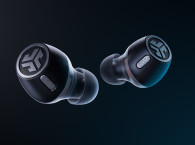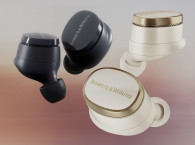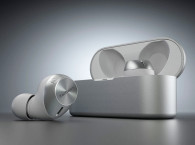
The JBuds Air Pro earbuds could very well be pitched for the exceptional battery life, or its low latency Movie Mode setting that ensures seamless matching of audio to video on device screens, combined with other features typically only found in products at much higher price points. The JBuds Air Pro offer 9+ of playtime on the earbud, Dual Connect technology that allows each bud to be used independently, and feature 6mm custom-designed dynamic drivers, with patented custom EQ3 sound. Otherwise, these TWS earbuds are an average Bluetooth 5.1 design with SBC and AAC, IP55 rating (earbuds), USB-C charging case, and are effectively very "normal" true wireless earbuds with touch controls that benefit from the extended experience that manufacturers and ODMs already have in the category.
JLab is a consumer electronics company from San Diego that since 2005 strives to offer the right features at the best value in personal audio gear and office accessories. Currently with five different SKUs in the JBuds Air series of true wireless products, including one slightly more expensive model with ANC, JLab decided to create a "Pro" model with a unique implementation of Bluetooth Multipoint, allowing users to pair their earbuds with more than one source, instantly switching between them when needed. The Bluetooth SIG calls this "multi-source Bluetooth", because basically it involves having the same sink device being able to receive sound from two "source" devices. Never simultaneously, since current Bluetooth technology doesn't allow multi stream.
As a selling point, as the company highlights, this makes the JBuds Air Pro stand out from all the top contenders in the disputed true wireless earbuds market, where leading products sell for more than $200 USD. It was also interesting enough for audioXpress to decide to write about this product, that would otherwise remain ignored in our inbox, together with the countless "me-too" TWS designs that reach the market every week.

Around for some time but never properly implemented, Bluetooth multipoint or multi-source was once advertised as a feature in office headsets that needed to switch calls quickly between a mobile phone and a PC. But effectively it never worked exactly as advertised. And the main reason has to do with the problem of switching between two different source devices that might be using different Bluetooth profiles and codecs. It is possible to previously pair to two different source devices and switch between them, as long as devices are streaming an AAC codec, for example. This worked well for Sony, Microsoft, and naturally Apple, which prioritize using AAC.
But even when it works once, it rarely works again as intended, because the switching is always cumbersome - usually it takes so much time that the user decides to "do something" about it, and stops the process. As an advanced feature in office headsets, this was explored mainly as way for users to be able to manage and switch between calls, and not high-quality music streams - which require more time to be detected and for the streaming to be switched. Again, reliability was always an issue, and this was before true wireless - where the two independent left/right earbuds almost always use proprietary schemes to enable the correct channel separation and synchronization.
For all those reasons, very few true wireless earbuds support multipoint and even Apple has been hesitant to promote the concept, even if in general it does support multi pairing and source switching. In fact, that feature is supported at the operating system level in Apple devices. But Apple usually implements auto-switching when it detects the user stopped listening to Apple Music on the iPhone and started watching a movie on a MacBook, as an example. That way, it avoids the possibility of user error, while at the same time also risking to become annoying when a movie is interrupted by the music that a member of the family decided to check out in daddy's iPhone. But at least it is able to prioritize calls. In it's documentation for developers, both for Mac OS and the External Accessory MFi program, Apple clearly advises: "Sound should not automatically switch from one device to another if you're in a conversation, like a phone call, a FaceTime call, or a video conference." But it doesn't explain why the AirPods that were previously paired and worked fine, suddenly insist on only working on another device.
Trying to do the same with a Windows laptop and an Android phone is a nightmare for audio manufacturers and never attempted. The Bluetooth 5 specification theoretically allows multi-source pairing, but manufacturers are afraid to tell consumers that it "only works with Samsung" or that they need to only use the latest-generation devices with the latest OS, Bluetooth profile and codec... Also, in the worse case scenario, it does work the first time, and then one day it doesn't - when the user wants to use the earbuds on a Zoom call on a laptop, they never show up as active and they persistently become active on a mobile phone, forcing the user to unpair, and redo the pairing - and risk loosing that important call.
Bluetooth LE Audio, when available, will potentially help to make this work much better since it supports multi-stream and its Audio Sharing and Broadcast Audio modes, finally enabling isochronous audio streams with multiple devices, which theoretically could facilitate multi-source as well - bearing in mind that those features are designed to allow one source to be received by many sink devices, not the other way around, and that an updated protocol is likely required. What we are missing are the details for that protocol in the new specifications - and assuming that protocol will be updated ,since the current one doesn't work well but hardly anyone cares.
The JBuds Air Pro are JLab’s first true wireless earbuds to include an implementation of Bluetooth multipoint, enabling the earbuds to transition "seamlessly" between devices without having to be paired again. While these are JLab’s first true wireless earbuds to use Bluetooth multipoint, the company also introduced the technology in its Work series of productivity-focused Bluetooth headphones. That we know of, only Apple and Jabra have done it in the TWS form-factor and they don't brag too much about it, for the reasons already described.

As JLab's anticipates in its user guide, the process of pairing with two devices simultaneously needs to be followed carefully, and it is difficult to explain to those who don't read the manual. And if Bluetooth pairing is clearly recognized by the whole consumer electronics industry as one of the biggest obstacles to its usability - and the reason why companies have created all sorts of workarounds for "fast-pairing" - from QR codes to NFC "kick-offs" for auto-pairing - expecting users to understand "sequential pairing" with switch on and switch offs of Bluetooth device settings is not likely to be something that becomes mainstream.
Also, not easy to explain that multipoint will not play media/music simultaneous from two source devices and that, "each device will first need to be paused followed by playing on the other device to function properly".
Why this is not a priority in the new Bluetooth specification, is a mystery to me. And another reason to believe that we will see increasingly proprietary implementations to circumvent existing limitations or to add "smart features".
The JBuds Air Pro earbuds even explore its two built-in MEMS microphones to enable an "exclusive" Be Aware Mode that deliberately allows outside noises into the ear, helping the wearer "hear the ambient sounds around them." A simple idea to promote something that basically could be offered by all TWS earbuds and a great way to appear to a more sophisticated design than the JBuds Air Pro actually is. Anyway, for those who cannot afford to pay more than $60 USD, this is probably worth trying. It might work for some.
"For some, money is no object. For most of us, it is. When performance, quality, and price matter, earbud users will be hard pressed to find a better option than JLab's JBuds Air Pro," says JLab CEO Win Cramer.
www.jlab.com








